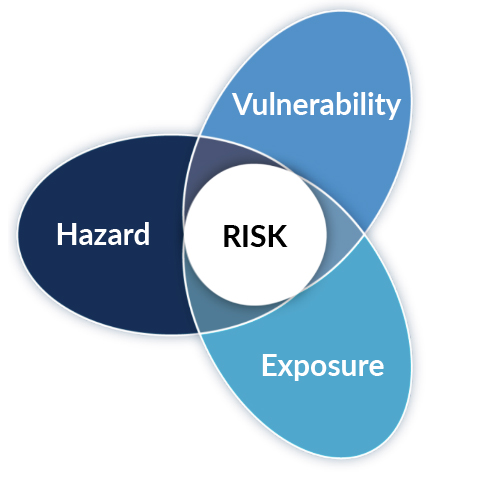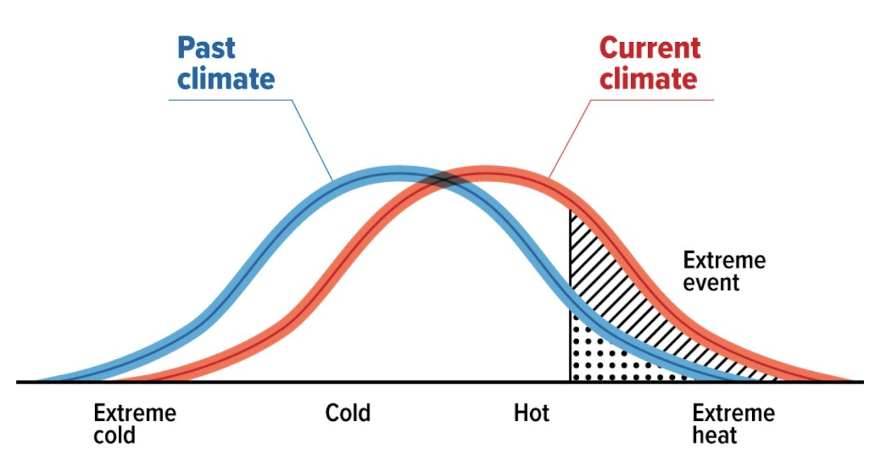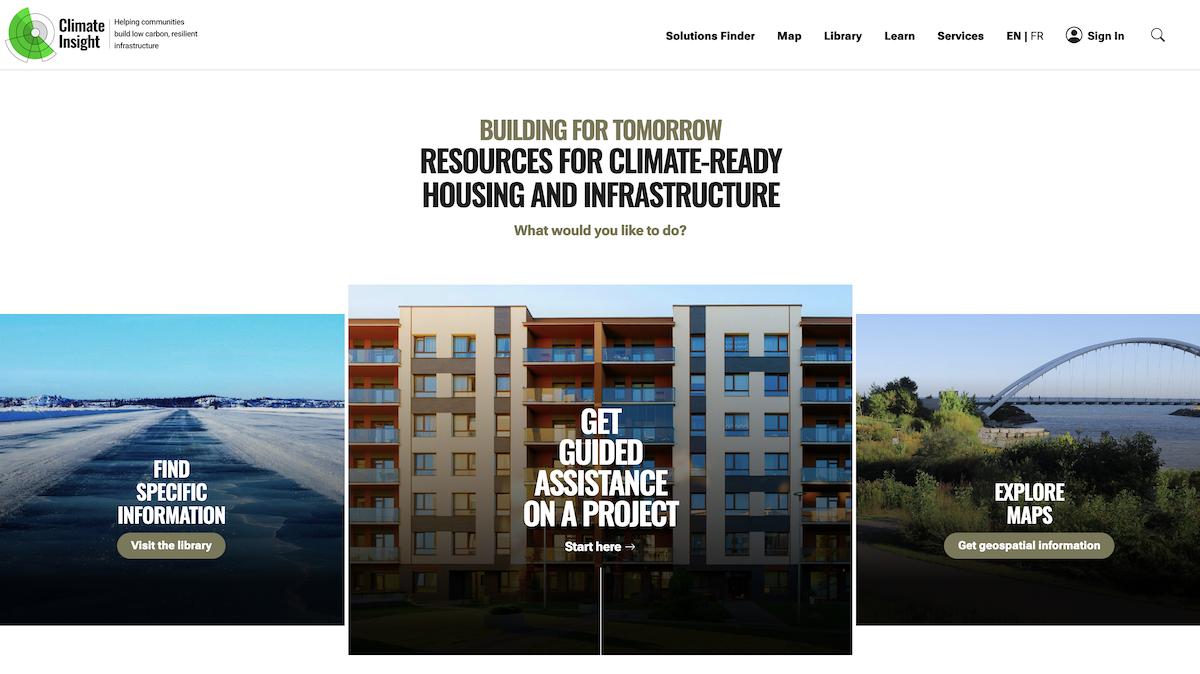
Climate change is happening. Understanding what the potential risks of climate change are helps us to prepare for them. Even with large efforts to reduce global emissions, we will still feel impacts from these changes, and the effects will be felt most heavily at the community level. It is therefore critical for communities to adapt, make changes, and reduce risk. This generally starts with a planning process called a climate risk assessment.
What is Climate Risk and how do we assess it?
Risk is a word we commonly use in our day-to-day lives. What is the risk of rain showers today? Should I go out without an umbrella? I’m not going to take that risk… Risk comes from the interaction between 3 components: hazard, exposure, and vulnerability. [1]

The 3 components of Risk: Hazard, Exposure, and Vulnerability. Diagram is adapted from the IPCC [2]
When we talk about climate risk, we are referring to risk posed by the impacts of climate change. [1]
Communities use a process called a climate risk assessment to explore how climate change is likely to affect them. Climate risk assessments can be performed at different scopes, depending on the approach. It can investigate a single asset or piece of infrastructure, look at a whole community, or be conducted for an entire region.
The climate risk assessment process investigates the connection between hazards, exposure, and vulnerability from the perspective of the community to help them understand their climate risks. Identifying the risks from climate change informs a community what they should prepare for.
Each community is made up of people that hold different views, values, objectives, and therefore each community’s risk assessment will be unique to them. [1] As a result, effective and equitable planning for climate change should be community-led and integrate perspectives from all members of the community.
Below is an explanation of how the components of a climate risk assessment are explored.
Hazards
The climate risk assessment process usually starts with identifying climate-related hazards that have affected or will likely affect the community. These can be single extreme weather events or gradual changes.
Read More: Examples of climate-related hazards
Climate-related hazards include extreme weather events and gradual changes in weather patterns. Examples of extreme weather events:
- Heatwaves
- Floods
- Drought
- Thunderstorms
- Tornadoes
- Hurricanes
Gradual changes happen over longer periods of time, and are not normally considered a single event. While these may occur more gradually, they can have significant impacts over time. Examples of gradual changes:
- Warming average temperatures
- Changes to the timing of seasons
- Thawing permafrost
- Changes in glacial melt
- Changes in river flow patterns

It is important to note that not all extreme weather events are caused by climate change. However, climate change can affect these events in different ways. Climate change can:
- Increase how often they happen,
- Increase their strength or intensity, and;
- Change when and where they occur.
Finding out how climate change affects a hazard in the future is an important step in climate risk assessment. This understanding helps communities know what to prepare for.
Exposure
Evaluating exposure starts with knowing what parts of a community may be affected by a hazard. Services, infrastructure, ecosystems, and people may all be exposed to a hazard, depending on where they are located.
For example, houses in a floodplain, and the people that live in them, are more exposed to flooding than those located further away.
In some cases, all people in a community might be exposed to a hazard. This is most relevant for hazards that take place over large areas, such as heatwaves. While everyone feels the high temperatures of a heatwave, some people might be more exposed. For example, people who work outdoors.
Mapping exposure to hazards in the community can increase understanding of where the risks lie.
Vulnerability
Vulnerability can be thought of in two aspects: Sensitivity and adaptive capacity.
Sensitivity is how much a person, asset, or community is affected by a hazard. Someone with high sensitivity is affected by a hazard more than others with lower sensitivity. For example, people with pre-existing heart conditions are more sensitive to extreme heat.
Adaptive capacity is the ability to cope with the stresses from a hazard. It is influenced by many factors, such as ease and willingness to adjust behaviours, and the supports, resources, and technologies available. For example, someone who has the ability to access cooling sites or air conditioning during extreme heat has a higher adaptive capacity than someone without access.
When conducting a climate risk assessment, a community should think about who and what is vulnerable, and what creates the vulnerability.
Read More: Factors of vulnerability
Vulnerability is determined through the interaction of many different factors. Below are some examples from a community and personal perspective.
Examples of community factors that could contribute to vulnerability:
- Age and condition of infrastructure
- Materials used in infrastructure
- Redundancies and backups of critical infrastructure
- Alternative deliveries of critical services
Examples of personal factors that could contribute to vulnerability:
- Pre-existing health conditions
- Financial stability
- Social supports
- Community connections
- Access to resources
- Access to programming
- Access to shelter
- Communication ease and ability
What to do with a climate risk assessment
A climate risk assessment explores hazards, exposure, and vulnerability, and provides an understanding of the climate risks a community faces and helps them prioritize which ones are most important to address. Some will be perceived as high risks and a significant threat, while others may be perceived as lower risks. This level of understanding helps communities prioritize their time and resources.
The results of a climate risk assessment are used to develop a plan that includes actions and strategies that reduce risk by limiting exposure and vulnerability to the climate hazard. This sort of planning is called climate change adaptation planning.
To learn more about the details of a climate risk assessment and adaptation planning process from a community perspective, read the case study on Yellow Quill First Nation.
Additional resources for climate change risk assessment and adaptation planning
There are many different climate risk assessment frameworks and toolkits available to the public. These are useful packages that present the climate risk assessment process step by step. Communities should choose a framework that works best for them, and make adjustments where necessary. Below is a list of climate risk assessment resources.
First Nations Infrastructure Resilience Toolkit (FN-IRT)
Developed and facilitated by the Ontario First Nations Technical Services Corporation, this toolkit is an adaptation of the PIEVC engineering standard for climate vulnerability and risk assessment on infrastructure, tailored for First Nations communities. The toolkit guides First Nations communities through assessing how extreme weather is likely to impact infrastructure, buildings, facilities, and natural assets given the effects of climate change.
Indigenous Climate Change Adaptation Planning (ICCAP) Toolkit
Created by the Centre for Indigenous Environmental Resources (CIER), the ICCAP toolkit is a series of user-friendly resources that help Indigenous communities along the climate change adaptation planning path. The toolkit consists of four components:
- Indigenous Climate Change Adaptation Guidance Document
- Climate Change Adaptation Planning Guide Books for Indigenous Communities
- Two Indigenous Language Glossaries
- Indigenous Languages Glossary Workbook
Climate Resilience Express Toolkit
This toolkit takes users through a workshop based approach to climate change adaptation planning. Through a 4 step process the toolkit guides users through scoping the planning process, assessing risks and opportunities, developing an action plan, and implementing the plan. The Climate Resilience Express Toolkit was developed by All One Sky, and aimed at municipalities and communities in Alberta.
Changing Climate, Changing Communities
Changing climate, changing communities guides through the climate change adaptation planning process. Consisting of 5 milestones that outline the different stages of the planning process, communities can make their way through a guide and supporting workbook to reach each milestone. Developed by Local Governments for Sustainability Canada (ICLEI), it is a part of their Building Adaptive and Resilient Communities (BARC) Program that develops a network of communities and municipalities working on adaptation planning to help support each other.
Climate Vulnerability and Risk Assessment, and Adaptation Guidance for Manitoba Communities (IISD)
A two part guide and workbook designed for Manitoba Communities. The first guide walks communities through the processes of identifying and assessing their climate risks and vulnerabilities. The second guide is focused on planning adaptation actions and implementing the climate change adaptation plan. The workbook is useful for organizing community data and recording progress towards the completed climate change adaptation strategy.
Up North on Climate
Climate change adaptation resources oriented towards communities in Northern Ontario. The series of resources are user friendly, with visuals and worksheets to help communities along the adaptation planning journey.
Read More: ClimateInsights Tool
Climate Insights is a publicly accessible website designed to support public infrastructure practitioners in decision-making processes. The site brings together climate-related information from a wide variety of trusted sources to provide the most relevant tools and data all in one place. Developed by ICLEI, the platform hosts curated information on risk assessments, emissions, tools, codes, standards, guidelines, and actions related to infrastructure, climate hazards, and greenhouse gas emissions.

To explore more visit the Climate Insights site
References
- 'Reisinger, Andy, Mark Howden, Carolina Vera, et al. (2020) The Concept of Risk in the IPCC Sixth Assessment Report: A Summary of Cross-Working Group Discussions. Intergovernmental Panel on Climate Change, Geneva, Switzerland. Pp15
- IPCC, 2012: Managing the Risks of Extreme Events and Disasters to Advance Climate Change Adaptation. A Special Report of Working Groups I and II of the Intergovernmental Panel on Climate Change [Field, C.B., V. Barros, T.F. Stocker, D. Qin, D.J. Dokken, K.L. Ebi, M.D. Mastrandrea, K.J. Mach, G.-K. Plattner, S.K. Allen, M. Tignor, and P.M. Midgley (eds.)]. Cambridge University Press, Cambridge, UK, and New York, NY, USA, 582 pp.
- Environment and Climate Change Canada. Extreme Weather Event Attribution. Government of Canada, n.d., https://www.canada.ca/en/environment-climate-change/services/climate-change/science-research-data/extreme-weather-event-attribution.html. Accessed 22 May 2025.
Recommended Article Citation
Climate Atlas of Canada. (n.d.) Basics of Climate Risk Assessment. Prairie Climate Centre. https://climateatlas.ca/basics-climate-risk-assessment









.png)


